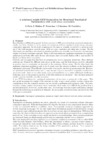Mostrar o rexistro simple do ítem
A minimum weight FEM formulation for Structural Topological Optimization with local stress constraints
| dc.contributor.author | París, José | |
| dc.contributor.author | Muíños Pantín, Iago | |
| dc.contributor.author | Navarrina, Fermín | |
| dc.contributor.author | Colominas, Ignasi | |
| dc.contributor.author | Casteleiro, Manuel | |
| dc.date.accessioned | 2005-12-05T11:34:02Z | |
| dc.date.available | 2005-12-05T11:34:02Z | |
| dc.date.issued | 2005 | |
| dc.identifier.uri | http://hdl.handle.net/2183/411 | |
| dc.description | 6th World Congresses of Structural and Multidisciplinary Optimization, Rio de Janeiro, 30 May - 03 June 2005, Brazil | es_ES |
| dc.description.abstract | Since Bendsoe and Kikuchi proposed the basic concepts in 1988, most of topology structural optimization results have been obtained so far by means of a maximum stiffness (minimum strain energy, minimum compliance) approach. In this kind of approaches, the mass is normally restricted to a given percent- age of the total maximum possible mass, while no stress constraints are taken into account. On the other hand, size and shape structural optimization problems are normally stated in terms of a minimum weight with stress constraint approach. These traditional minimum compliance statements for topology optimization problems offer some obvious advantages, since one avoids dealing with a large number of highly non-linear stress constraints. However, one can argue that this kind of statements has several important drawbacks. Thus, different solutions are obtained for different restrictions on the mass, and the final design could be unfeasible in practice since no constraints are imposed on the maximum allowed stress. On the other hand, the minimum compliance problem is said to be ill-posed, since the solution oscillates as the discretization refinement is increased. This dificulty can be easily overcome by introducing porous materials. However, an optimized material distribution with a large amount of porous material is frequently considered an unwanted result. And, on the other hand, numerical instabilities occur unless additional stabilization techniques (such as the perimeter method, or the filter method) are employed. Thus, the final optimized results normally resemble truss-like structures. A new FEM formulation for topological optimization of structures is presented in this paper. This new model minimizes the weight of the structure in order to get a more realistic solution, taking into consideration that the materials stresses can not exceed a predetermined maximum value. One gets, therefore, a large number of nonlinear stress constraints which make more difficult the problem from a mathematical point of view but, on the other hand, this technique does not require stabilization schemes because the restrictions are stated in all elements. As an example, several structures optimized with this technique are presented. | es_ES |
| dc.format.mimetype | application/pdf | |
| dc.format.mimetype | text/plain | |
| dc.language.iso | eng | es_ES |
| dc.subject | Topological optimization | es_ES |
| dc.subject | Minimum weight | es_ES |
| dc.subject | Finite element method | es_ES |
| dc.subject | Stress constraints | es_ES |
| dc.title | A minimum weight FEM formulation for Structural Topological Optimization with local stress constraints | es_ES |
| dc.type | info:eu-repo/semantics/conferenceObject | es_ES |
| dc.rights.access | info:eu-repo/semantics/openAccess | es_ES |






